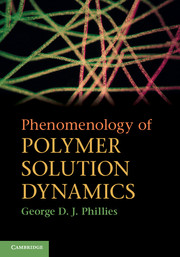Book contents
- Frontmatter
- Contents
- Preface
- 1 Introduction
- 2 Sedimentation
- 3 Electrophoresis
- 4 Quasielastic light scattering and diffusion
- 5 Solvent and small-molecule motion
- 6 Segmental diffusion
- 7 Dielectric relaxation and chain dimensions
- 8 Self- and tracer diffusion
- 9 Probe diffusion
- 10 Dynamics of colloids
- 11 The dynamic structure factor
- 12 Viscosity
- 13 Viscoelasticity
- 14 Nonlinear viscoelastic phenomena
- 15 Qualitative summary
- 16 Phenomenology
- 17 Afterword: hydrodynamic scaling model for polymer dynamics
- Index
14 - Nonlinear viscoelastic phenomena
Published online by Cambridge University Press: 05 August 2012
- Frontmatter
- Contents
- Preface
- 1 Introduction
- 2 Sedimentation
- 3 Electrophoresis
- 4 Quasielastic light scattering and diffusion
- 5 Solvent and small-molecule motion
- 6 Segmental diffusion
- 7 Dielectric relaxation and chain dimensions
- 8 Self- and tracer diffusion
- 9 Probe diffusion
- 10 Dynamics of colloids
- 11 The dynamic structure factor
- 12 Viscosity
- 13 Viscoelasticity
- 14 Nonlinear viscoelastic phenomena
- 15 Qualitative summary
- 16 Phenomenology
- 17 Afterword: hydrodynamic scaling model for polymer dynamics
- Index
Summary
So far we have considered linear transport phenomena, in which the response is directly proportional to the circumstance causing the response. Polymer solutions, however, are fundamentally nonlinear, and show a wide variety of additional behaviors not expected from simple linear descriptions. These behaviors may be divided, somewhat crudely, into unusual flow behaviors arising from nonzero normal stress differences, time-dependent phenomena in which the system shows memory, so that the response to a series of forces depends on when they were applied, and several modern discoveries not discussed in more classical references.
At some point, the constraints of time and space insist that the discussion be curtailed, so we here present a taxonomy of nonlinear viscoelastic phenomena, without the considerable quantitative analyses seen in prior chapters. The objective is to represent the range of observed phenomena and provide references that give entrées into the literature. No effort has been made to give a thorough collection of published results. If Lord Rayleigh's critique – science is divided between quantitative measurement and stamp collecting – is invoked on this chapter, the stamps are indeed beautiful, but are likely to be more thoroughly quantitatively examined when readers become aware of their existence.
Normal stress differences
A variety of the classical unusual flow effects seen with polymer solutions can be traced back to the normal stress differences N1 and N2. A full mathematical description becomes quite lengthy, and may be found in Graessley(1).The following remarks provide an exceedingly compressed description.
- Type
- Chapter
- Information
- Phenomenology of Polymer Solution Dynamics , pp. 445 - 458Publisher: Cambridge University PressPrint publication year: 2011



